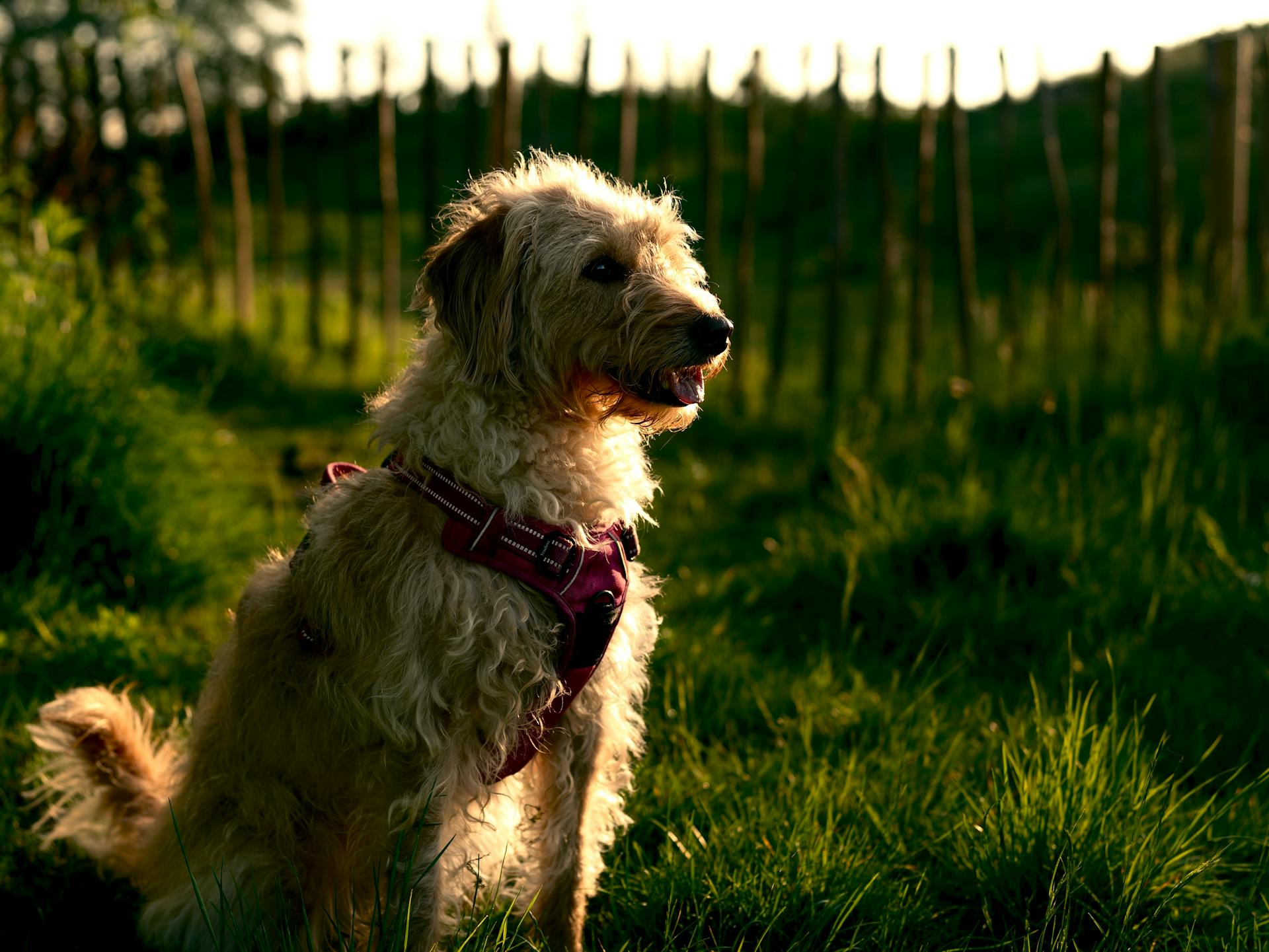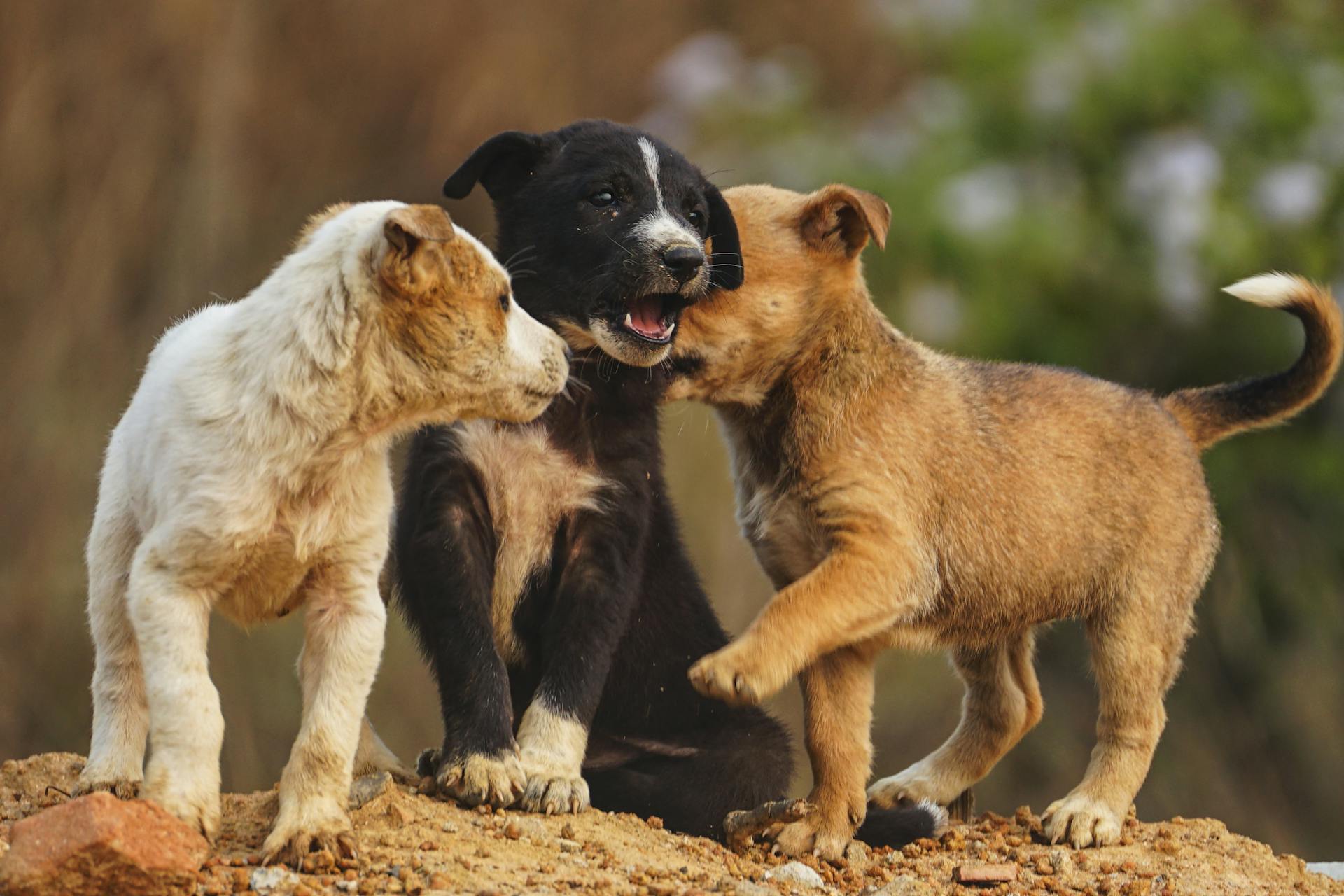
The Great Pyrenees Lab Mix is a unique and fascinating breed that combines the gentle giant qualities of the Great Pyrenees with the energetic and intelligent nature of the Labrador Retriever.
They typically weigh between 70-110 pounds and stand between 23-28 inches tall at the shoulder.
Great Pyrenees Lab Mixes are known for their thick double coats, which require regular grooming to prevent matting and tangling.
Their exercise needs are moderate to high, requiring daily walks and playtime to keep them happy and healthy.
A Great Pyrenees Lab Mix can live for 10-12 years with proper care and attention.
Breed Information
The Great Pyrenees Lab mix, also known as the Pyrador, is a crossbreed between a Great Pyrenees and a Labrador Retriever. They're a relatively new designer dog, registered with the Dog Registry of America, but not officially recognized by the American Kennel Club.
This crossbreed combines the loyalty and trainability of the Labrador with the companionship and protective nature of the Great Pyrenees, making them a perfect family dog suited to the outdoors and long walks. They're also known to be friendly and loyal.
In terms of size, Pyrador dogs are large, with males ranging from 25 to 29 inches tall and weighing between 80 to 100 pounds, while females are slightly smaller, between 23 and 27 inches tall and weighing between 70 to 90 pounds.
Their coat is a medium to long, thick double coat, and they come in a variety of colors including white, grey, beige, black, cream, yellow, and brown. They have a lifespan of between 10 to 12 years.
Here's a summary of the Pyrador's key traits:
Physical Characteristics
The Great Pyrenees Lab mix is a large breed, typically standing between 23 to 32 inches in height at the shoulder.
Their weight can vary, but on average, they weigh between 70 to 110 pounds, influenced by factors such as genetics, diet, and exercise.
Their robust build and strong bone structure are inherited from the Great Pyrenees, giving them a well-muscled body and an air of elegance and strength.
The Labrenees showcase a remarkable range of coat variations, from the luxurious, thick fur of the Great Pyrenees to the sleek, water-resistant coat of the Labrador Retriever.
Their coat color palette is diverse, including shades of white, cream, black, brown, and gray, which can manifest in solid coats or striking combinations.
The Labrenees typically boast a bushy tail that elegantly trails behind them as they move, and their ears can vary in shape and size, ranging from erect to pendant.
Male Pyrenees Lab mixes are slightly bigger and heavier than their female counterparts, but their size can vary depending on individual factors.
Their height is typically between 23 to 29 inches, and their weight can range from 70 to 100 pounds.
Pyradors will have a thick and fluffy double coat that sheds heavily during shedding season and moderately throughout the year.
Their coat colors can include white, cream, yellow, brown, or black, and they may take one solid color or a combination of colors.
Discover more: Colors of Great Pyrenees Dogs
Grooming and Shedding
The Great Pyrenees Lab mix is a double-coated breed, which means they shed heavily, especially during spring and fall. They shed moderately throughout the rest of the year.
Be prepared for a lot of hair, as Pyradors shed copiously all year round. Drifts of shed hair will be visible in your home, especially during spring and autumn.
Brushing your Pyrador a couple of times a week will help manage their shedding. Using a deshedding tool like a Furminator will also loosen and remove dead hair.
Their coat is relatively low maintenance, but it's essential to avoid clipping or excessive washing, which can damage the natural coat oils. Unless they've rolled in something awful, they rarely need a bath.
A bath every 8 to 12 weeks should be sufficient, as their coat is dirt-resistant and relatively clean. Regular ear cleaning is also necessary due to their large ears, so clean their ears twice a week to prevent infections or a buildup of wax.
Readers also liked: Do Great Pyrenees Dogs Shed a Lot
Exercise & Living Conditions
A Great Pyrenees Lab mix needs around 60 minutes of exercise every day, combining long walks with higher-intensity playtime.
Their exercise needs can vary depending on which parent they take after most, with some requiring more strenuous and interactive activities, while others prefer calmer exercise.
They will appreciate a large outdoor space to roam in, play in, and just be, with high fences to prevent escape and protect their potential protective instincts.
Water activities are a great way to exercise your Pyrador, as they come naturally to them and don't place stress on their bones or joints.
Swimming can help improve their cardiovascular system and reduce the risk of developing elbow or hip dysplasia, making it a great option for this breed.
In terms of living conditions, their home should be large enough to accommodate their big size, and they will do well with other household pets if socialized well as a pup.
They may also have an affinity for smaller and younger family members, and will likely sit guard next to them as they play, so be sure to supervise them with children around due to their size.
For more insights, see: Will a Great Pyrenees Attack an Intruder
Health and Care
As a Great Pyrenees Lab Mix owner, you're likely aware of the importance of proper care and health maintenance for your furry friend. This breed is prone to joint diseases, so it's essential to take preventative measures.
To minimize the risk of joint diseases like hip dysplasia and elbow dysplasia, look for a breeder who has health-tested both parents and has certificates to prove they're free from joint disease.
Feeding your puppy an age- and breed-appropriate diet is crucial to prevent weight gain and joint strain. Limit leash walking and stair climbing while they're still growing to prevent putting too much pressure on their joints.
Regular veterinary check-ups are vital for detecting potential health issues early. Schedule routine visits to the veterinarian for comprehensive health check-ups and vaccinations.
A balanced diet, regular exercise, and mental stimulation are key to promoting overall health and well-being. Provide your Great Pyrenees Lab Mix with plenty of opportunities for physical and mental activity.
If this caught your attention, see: Hip Dysplasia in Great Pyrenees
Some common signs of illness in dogs include changes in appetite, behavior, or energy levels. If you notice any concerning symptoms, seek veterinary care promptly.
Here are some potential health concerns to be aware of:
- Hip & Elbow Dysplasia: Abnormal formation of the hip and elbow joint, which can be inherited from either parent or caused by rapid bone growth as a puppy.
- Eye conditions: Late-onset Progressive Retinal Atrophy, Cataracts, or Entropion, which can be inherited from the Labrador breed.
- Patella Luxation: Dislocation of the kneecap from its normal position on the thigh bone.
Training Your Dog
Training your Great Pyrenees Lab mix requires patience, consistency, and positive reinforcement. This is especially true if your Pyrador takes after the Great Pyrenees parent, who can be stubborn and independent.
Socialization is crucial for a Great Pyrenees Lab mix, and it's essential to start training them as soon as possible. You can expect to pay $76 per month in food costs, which can help you plan for the expenses.
To socialize your Pyrador, introduce them to new people, animals, and environments gently and with treats. This will help them form positive associations and build confidence. A Pyrador that's well-socialized will be less likely to be wary of strangers.
All dogs need to be potty trained, and crate training is a good way to save your furniture from Labrador puppies' notorious chewing. Your Pyrador will also need to learn good manners around people, such as not jumping up at strangers.
Consistency and persistence are key when it comes to training a Pyrador, especially if they take after the Great Pyrenees parent. Positive reinforcement methods will help them understand what you want from them.
A different take: Do Great Pyrenees Make Good Pets
Diet and Nutrition
The great Pyrenees lab mix is a big dog, and with that comes a bigger need for food. They'll need around three cups of high-quality kibble every single day.
It's essential to feed them high-quality food to avoid rapid bone growth, which can lead to health issues like hip and elbow dysplasia. Look for kibbles specifically designed for large breeds.
If your Pyrenees lab mix takes after the Labrador, be prepared for a big appetite. They'll keep on eating, so it's crucial to supervise their food intake and spread it out into smaller portions throughout the day.
Pyradons are prone to obesity, thanks to the Labrador influence, so it's vital to limit their food intake and ensure they get enough exercise. However, don't overdo it – they need time to digest and rest after eating.
Here's a rough estimate of the costs involved in feeding your Pyrenees lab mix:
- $28 to $30 a month for dry dog food
- $36 for a month's supply of wet food
- Around $10 a month for treats
Remember to consult with a veterinarian to determine your dog's specific nutritional needs based on their age, weight, and activity level. This will help you provide a well-balanced diet that meets their needs.
Getting a Dog
Getting a dog is a big responsibility, and it's essential to consider whether you have a suitable lifestyle and living conditions for a Great Pyrenees Lab mix. You need to think about whether you have the time and energy to properly take care of one.
You'll also need to consider your living space. If you live in an apartment in the city, a Pyrador is not the best fit. They need room to grow and thrive in a healthy manner.
Pyradors can be expensive, with prices ranging from $500 to $1500 when sourced from a breeder. However, you can also look for a Pyrador in animal shelters and adoption centers, which can be a more affordable option and give a loving home to a dog in need.
A unique perspective: Great Pyrenees Exercise
Getting a Dog
Getting a dog is a big decision, and it's essential to consider whether you're ready for the responsibility. You'll need a suitable lifestyle and living conditions to provide a healthy environment for your dog.
Before bringing a dog home, think about your living situation. If you live in an apartment in the city, it's not the best idea, as dogs like the Great Pyrenees Lab mix need space to grow and thrive.
You'll also need to consider the financial aspect, as buying a puppy from a breeder can cost between $500 to $1500. However, you can find a Pyrador in animal shelters and adoption centers, which can be a more affordable option.
Having a dog is a significant investment, but it's a priceless experience to give a loving home to a dog in need.
Finding a Puppy
Finding a puppy can be a daunting task, especially if you're looking for a specific breed like a Pyrador. Finding Pyrador puppies for sale is relatively easy, especially if you're willing to travel.
Be cautious of puppy mills, which prioritize profit over the welfare of the puppies. Puppies raised in these environments are more likely to have behavioral problems and lifelong health conditions.
When searching for a reputable breeder, look for signs that they're raising their puppies with care, such as a clean and well-maintained facility.
Am I Eligible?
Getting a dog is a big decision, and it's essential to consider whether it's right for you. A black Pyrador isn't for everyone.
Before bringing a dog home, think about your lifestyle. If you have a busy schedule or travel frequently, a high-maintenance breed might not be the best fit. A Great Pyrenees Black Lab Mix, for example, needs regular exercise and attention.
Consider your living situation as well. If you live in a small apartment, a large breed like a Great Pyrenees might not be suitable. On the other hand, if you have a big yard, a high-energy breed could be a great match.
Think about your family dynamics too. If you have young children, a gentle and patient breed like a Labrador Retriever might be a better choice. If you're looking for a low-shedding breed, a Black Lab might be a good option.
Ultimately, the decision to get a dog depends on your unique circumstances and needs. Take the time to research and consider your options carefully.
For more insights, see: Great Pyrenees Breed Standard
Temperament and Behavior
The Great Pyrenees Lab mix is a unique breed that combines the best traits of both parent breeds. They are generally very friendly and great with families and children, making them a great addition to any household.
However, as they are quite large in size, they should be supervised with younger children, and trained to be extra gentle and careful. This is especially important when it comes to protecting their family, as they can be quite protective due to their Great Pyrenees heritage.
They are also easy to train, as they are very intelligent. This makes them a great breed for first-time dog owners or those who want a low-maintenance pet.
But, as mentioned earlier, they might struggle to settle down and sleep at night, as the Great Pyrenees is naturally more nocturnal. This means they'll be on the lookout for intruders, so you can expect some barking at the bats and owls in the early hours of the morning.
Curious to learn more? Check out: Is a Great Pyrenees a Giant Breed
Here's a breakdown of the Great Pyrenees Lab mix's temperament and behavior:
As they are a crossbreed, their temperament can be a bit unpredictable. They might take after the Labrador parent, the Great Pyrenees parent, or a mix of both. It's essential to ask about the parents to get an idea of what to expect.
If the Pyrador takes more after the Great Pyrenees, they will be extremely loyal, which can lead to territorial and protective behavior towards strangers. They are alert and protective and have a very strong sense of family, so they will be great with children and with other household pets.
Their energy levels are also worth mentioning. As a mix of a Labrador and a Great Pyrenees, they will be very energetic throughout the day. They love to play fetch with their humans and will require plenty of exercise to keep them happy and healthy.
Overall, the Great Pyrenees Lab mix is a wonderful breed that makes a great family pet. With the right training and socialization, they can thrive in a variety of living situations.
A unique perspective: Are Great Pyrenees Protective
Family and Living
The Great Pyrenees Lab mix is a wonderful addition to any family, but it's essential to consider their living needs to ensure they thrive. They require a lot of space to roam around, so a large outdoor area with high fences is a must.
A Great Pyrenees Lab mix needs around 60 minutes of exercise every day, which can be a mix of strenuous and interactive activities, depending on their temperament. This means they're best suited for active families who can keep up with their energy levels.
Their large size means they'll need a spacious home to accommodate them, both indoors and outdoors. They'll appreciate having a big yard to play in and run around.
As a protective breed, they'll be loyal guardians of their family, especially the smaller and younger members. However, it's crucial to supervise them with children around due to their size.
To ensure they're well-balanced, socialization is key, especially during their puppy years. With proper training and socialization, they'll be great with other household pets and newcomers.
Here are some key living requirements for a Great Pyrenees Lab mix:
- Large outdoor space with high fences
- At least 60 minutes of exercise per day
- Spacious home to accommodate their size
- Active family to keep up with their energy levels
- Supervision with children around
- Proper training and socialization
Life Expectancy and Growth
A Great Pyrenees Lab mix can live for 10-20 years, which is a significant commitment for any dog owner.
Their growth rate is also noteworthy, with males reaching between 25 and 29 inches tall and weighing between 80 and 100 pounds, while females reach between 23 and 27 inches tall and weigh between 70 and 90 pounds.
Some Pyradors can even grow larger, with weights up to 120 pounds recorded in some cases.
Breed Dog Life Expectancy
A dog's life expectancy can vary depending on the breed and mix. The Great Pyrenees Lab mix lifespan is 10-20 years.
Some dogs grow faster than others, with the Great Pyrenees Lab mix reaching full size between 1-2 years.
The lifespan of a mixed breed dog like the Great Pyrenees Lab mix can be influenced by its individual parent breeds. The Great Pyrenees Lab mix lifespan is 10-20 years.
Dogs that live in optimal conditions tend to live longer, so providing a comfortable home is crucial.
Broaden your view: Great Pyrenees Dogs 101
When Is a Dog Full-Grown?
A dog's full-grown size can vary depending on its breed and genetics. For a Great Pyrenees Lab mix, males will typically reach between 25 and 29 inches tall, while females will reach between 23 and 27 inches.
Some dogs can grow much larger than expected, like the Great Pyrenees Lab mix that weighed 120 pounds. This is why it's essential to consider your dog's adult size when choosing a living space.
Males will usually weigh between 80 and 100 pounds, while females will weigh between 70 and 90 pounds. This is crucial to ensure your dog has enough room to move around comfortably.
A large living space is a must for dogs like the Great Pyrenees Lab mix, as they won't fare well in a small apartment.
Suggestion: Are Great Pyrenees Herding Dogs
Common Issues and Misconceptions
Both Great Pyrenees and Lab mixes can be prone to certain health issues, so it's essential to be aware of these potential problems.
Great Pyrenees are more likely to develop canine multifocal retinopathy, a degenerative eye disease.
Lab mixes, on the other hand, are at higher risk for degenerative myelopathy, a progressive neurological condition.
If you're considering bringing a Great Pyrenees Lab mix into your family, make sure to research reputable breeders who prioritize health testing and transparency.
Breed Specific Issues
Breed Specific Issues can be a major concern for many dog owners. Some breeds are prone to certain health issues, and it's essential to be aware of these potential problems before bringing a new furry friend home.
Great Pyrenees and Labradors are two breeds that can be affected by specific health issues. Both breeds are prone to degenerative myelopathy, a neurological condition that can cause progressive weakness and paralysis.
Exercise induced collapse is another issue that Labs are more likely to experience. This condition can cause a dog to suddenly collapse after exercise or excitement.
On a similar theme: Common Problems with Great Pyrenees
Great Pyrenees, on the other hand, are more prone to canine multifocal retinopathy, a disease that affects the retina and can cause blindness. They are also more likely to develop thyroid disease, which can affect their overall health.
To avoid these issues, it's crucial to work with a reputable breeder who has health-tested their dogs. Look for breeders who advertise the health tests they've commissioned and are willing to share the results with you.
Here are some breed-specific issues to be aware of:
- Great Pyrenees: canine multifocal retinopathy, degenerative myelopathy, neuronal degeneration, and thyroid disease.
- Labs: degenerative myelopathy, exercise induced collapse, progressive retinal atrophy, and thyroid disease.
Common Misconceptions
Labrenees may appear intimidating due to their size, but their temperament is largely influenced by their upbringing and socialization.
Their size can be a misconception, as Labrenees can be gentle and friendly companions with proper training and care.
You don't need a large yard to raise a Labrenees, as they can adapt well to various living situations, including apartments, as long as they receive adequate exercise and mental stimulation.

Labrenees can thrive in apartments, making them a great option for city dwellers or those with limited outdoor space.
Their luxurious coat requires regular brushing and routine maintenance to manage seasonal shedding and keep it in good condition.
With proper training and socialization, Labrenees can get along with other pets and even be wonderful family pets, especially when raised with children.
Early socialization and training play a significant role in how Labrenees interact with other pets, making them a great option for families with multiple pets.
Take a look at this: Training a Great Pyrenees
Overview and Review
The Great Pyrenees Lab mix, also known as the Pyrador, is a relatively new crossbreed that combines the loyalty and trainability of the Labrador with the companionship and protective nature of the Great Pyrenees.
This designer dog is perfect for families who love the outdoors and want a loyal companion for long walks. The Pyrador's size is impressive, with males reaching 25-29 inches in height and weighing between 80-100 pounds.
As a crossbreed, the Pyrador's temperament can vary, but they are generally very friendly and great with families and children. However, they do require supervision with younger kids due to their large size.
The Pyrador's intelligence makes them easy to train, but they might struggle to settle down and sleep at night due to their natural nocturnal tendencies. It's essential to ask about the parents' temperament to get an idea of what to expect.
Here's a summary of the Pyrador's key traits:
Overall, the Pyrador is a wonderful companion for active families who want a loyal and loving pet.
Frequently Asked Questions
Is a pyrador a good dog?
The Pyrador is a loyal and loving companion, making them a great addition to many families. Their intelligent and affectionate nature also makes them relatively easy to train and interact with.
How long do pyradors live?
Pyradors typically live for 10-12 years. Regular exercise is crucial to ensure a long and healthy life for this breed.
Featured Images: pexels.com


